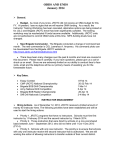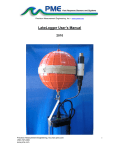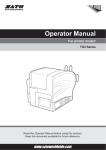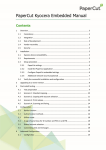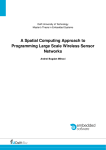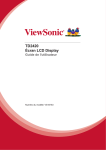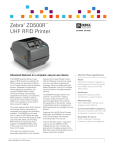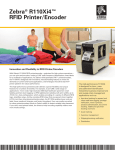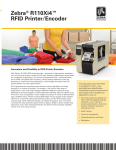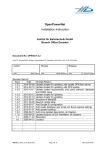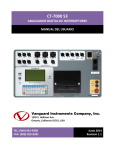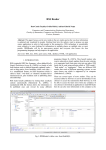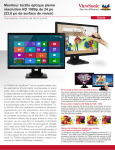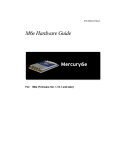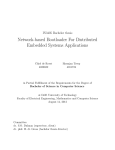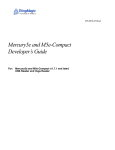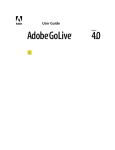Download Formal Report
Transcript
Formal Report Team : Step By Step INTERACTIVE CAMPUS MAP INTERACTIVE CAMPUS MAP (ICM) Step By Step 1301 16 Ave NW, Calgary, AB T2M 0L4 Phone 403.284.7248 TABLE OF CONTENTS Interactive Campus Map (ICM) ............................................................................................................................... i Executive Summary ............................................................................................................................................... 1 Problem Oportunity ............................................................................................................................................... 2 objectives............................................................................................................................................................... 2 Background ............................................................................................................................................................ 3 Project team and stakeholders .............................................................................................................................. 3 Project Scope and out of scope ............................................................................................................................. 4 Project Scope ..................................................................................................................................................... 4 OUT OF SCOPE ................................................................................................................................................... 4 Project details .................................................................................................................................................... 5 Budget ................................................................................................................................................................... 8 Original Budget .................................................................................................................................................. 8 Actual Budget .................................................................................................................................................. 12 Discussion of results of achievements ................................................................................................................. 14 Lessons learned ................................................................................................................................................... 16 Technical Lessons That Were Learned ............................................................................................................. 16 Lessons Learned While Configuring The Server: .......................................................................................... 16 Lessons Learned While Creating and Configuring The Database: ................................................................ 16 Lessons Learned While Configuring The Motherboard: .............................................................................. 16 Lessons Learned While Creating the Interface ............................................................................................ 17 Lessons Learned While Configuring The NFC Reader: ................................................................................. 17 Lessons Learned While Configuring The Teensy 3.0: ................................................................................... 17 Lessons Learned While Configuring the Thing Magic Reader: ..................................................................... 17 Lesson Learned While Creating The Terminal:............................................................................................. 17 Lessons Learned While We Were In The Final Stage Of Completing The Project: ....................................... 17 Personal Lessons We Learned While Working On the Project ............................................................................. 18 Future uses .......................................................................................................................................................... 18 Conclusion ........................................................................................................................................................... 18 Acknowledgements ............................................................................................................................................. 19 Bibliography ......................................................................................................................................................... 21 Terminology ......................................................................................................................................................... 23 EXECUTIVE SUMMARY This document outlines the initiation, vision, and goals of our four-month ITCS fourth semester Capstone Project: I.CM, an interactive RFID enabled map terminal. The project itself will be completed by the workgroup: Step By Step, consisting of Giannina Cattabeni, Katie Clarke, and Dan Wollach with the support of the RAD lab of SAIT Polytechnic. The existing problem is that SAIT has need of an efficient way for people who are new to the campus to navigate to their destination such as new students or guests of the school. RFID tags in a student’s ID card will be able to pull up their class schedule and other relevant information on the fly and give guests without a SAIT id card an interactive way to find the right building. The manufacturing of this device will require our skills that we have developed through the ITCS program and therefor will include categories such as programming, scripting, networking, hardware integration, server database administration, and security. Other Skills out project has required is building skills in which we have had help on. Also in this document we have included the primary stakeholders affected by this project, as well as the project team itself, the scope of our work as well as what falls outside of our scope, lessons learned, a breakdown of our budget, and finally our conclusions. Appended to this report, you will find a glossary of important terms, a Gantt chart detailing the workflow of our project, the User Manual we have created for future maintenance, and the Administrators manual as well as all the scripts and coding we have used. 1|P a g e PROBLEM OPORTUNITY The problem with large campuses such as SAIT is that they are big and often hard to navigate if you are new to the school. The aim of our project is to address this by giving students and guests an interactive way to find their destination. Another issue is new students being unfamiliar with their schedules and without access to a computer might not be able to find the right class without being very late. By being able to pull up your schedule at one of these terminals while on the go would help students get to class on time. Students who are new to SAIT may also not be aware of all the activities and services SAIT has to offer. By advertising these on the terminals when a student uses them they might find access to new resources they weren’t aware of therefore enhancing their experience at SAIT. OBJECTIVES A functional interactive map that will be able to lead students to their next class. The terminal will advise students of all the student resources the campus has to offer. The terminal will be able to read the RFID tags, successfully pull out student schedules, and find the information based on their personal needs. UHF antennas will scan for all RFID tags within range and will load student information, however it will only display the information that is pulled when the student ID makes contact with the NFC reader. The terminal will light up using LED lights that will be personalized by the students. The database will be properly secured to prevent intrusion and stolen data. 2|P a g e BACKGROUND Our Project is meant for the students of SAIT. As the campus is ever-growing with many tools and activities at the student’s disposal, unfortunately not all of these tools or activities are known/used by the existing and new students of SAIT. The Terminal we have built will include an interactive map of the SAIT campus and connect to student information using RFID. This has been accomplished by integrating different industry standards and equipment within a stationary terminal. The terminal is connected to a main network database which will retain the observed RFID tags until requested from the computer inside the terminal. The information will be transferred over a password protected Wi-Fi network between the terminal and the database server which will then retrieve the necessary information. Additionally, we have integrated LED lights in the terminal to respond and light up to UHF tags in the ID cards using UHF antennas, this will make the user experience more personalized and memorable. PROJECT TEAM AND STAKEHOLDERS Stakeholders Comment Project Members Giannina Cattabeni, Katelyn Clarke, Daniel Wollach Client Southern Alberta Institute of Technology (SAIT Polytechnic) Performing Organization Step by Step Client SAIT Sponsor Ben Reed 3|P a g e PROJECT SCOPE AND OUT OF SCOPE PROJECT SCOPE Given that we only had such a small period of time to complete this project, we had to stay within our set scope the team came up with in mid-December. Within the scope we created we had to cover several components of this project that encompass all sectors of Information Technology. In order to implement a seamless communication between the different hardware and software components within I.C.M. we had to demonstrate our knowledge of server services, database administration, programming, networking, and configuring computer based hardware. We accomplished this in the following way: Planning and Timeline o We created a Gantt Chart and strategy to get all of our project requirements done Hardening the server o Server Hardened to comply with security components Getting and putting together our Hardware o Put together motherboard, teensy and M6e Micro components Setting up the needed software o Put operating system on Server and on terminal motherboard o Getting software for database, teensy and M6e Micro Planning and created necessary code o Plan out and create code for NFC cards, teensy and M6e Micro Documentation o User Manual o Administrators Manual o Source Code Documentation o Gantt Chart o Formal Report OUT OF SCOPE We found that with our project I.C.M. It was so easy to go “Out Of Scope” and come up with many ideas that we could also do with the project. One out of scope idea our team came up with had to do with the potential for more enhanced interactive user experience, in a way the students could participate in a scavenger hunt around campus. Another feature that was “Out Of Scope” was the ability for the terminal to be integrated with other campus systems such as being able to book a study room in the library instead of having to go to the library later. We also had the idea of implementing QR codes to our map displays so that the user may scan it and take a copy of the map with them, or developing some sort of mobile application so that the students can access the I.C.M map feature, but also be able to access their schedules and other personal information. 4|P a g e PROJECT DETAILS Since our project required a database and a webserver in order to function, our project had to be programmed in a variety of different programming languages: Wrote a Perl script to read through the NFC results page and pulls out the specific card ID number which would then print it to an outfile. Created a SQL database in HeidiSQL to connect to the interface [1] Used JavaScript programing for floatbox [2] and numeric keypad Used HTML to create our interface pages. Used CSS to enhance the interface page. Wrote PHP scripts to connect the terminal interface to the database. For the Security components for our project: We hardened both the server and the database -In our server the share folders were disabled in the registry key, and the temp folder was encrypted for security purposes -The database was hardened by creating a password when database read information from NFC tags We implemented network security for the Wi-Fi connection and the terminal by providing a secure password for our router. We also implemented physical security of the terminal and its contents by creating a terminal housing framed with angle iron, and acrylic. 5|P a g e During the project we had to configure and maintain many hardware components for our project so that it was able to have fully functionality. The hardware components we used for our project were the following: An ASUS Motherboard [3], which held components such as a solid state drive, an Intel CPU processer, a USB Network adapter and 4 GB RAM A TR2 600W Power Supply [4] A ThingMagic M6e 4 port UHF RFID module [5] A teensy 3.0 to program our LED components [6] Two ThingMagic Astra External [RHCP] Indoor Antennas [7] and a SCL011 Contactless/ NFC Desktop reader [8] to pick up signals A View Sonic TD2420 24’’ touchscreen monitor [9]to display our interface and give the users an interactive experience A UPS to provide power for our motherboard Server Administration We used D5387 G7 Server [10] where we held our database. o Used Windows 7premium [11] as an image on the server o Used HediSQL [1]to hold the database Webserver o Used Windows 7 premium [11] as our image. o We installed an Apache client called Xampp [12] to act as a webserver which hosts our terminal interface. 6|P a g e User Experience We created a terminal that first year IT students can use to access their student schedules with using their student ID cards (NFC integrated) Students will then enter their password which we added as a security feature, the terminal will then display their information such as their class schedule. Students will also have the option to view directions to specific classes using a 2-D map view or via video walkthroughs. The students will also notice that before fully interacting with the terminal the UHF tag implemented on the ID card will be read by the UHF antennas which then will display a unique color provided by the LED’s. 7|P a g e BUDGET ORIGINAL BUDGET Our original Budget submitted with our team charter: Hardware Item Description Number of Items Total Cost Thermal Take TR2 600W power supply Power Supply 2 $ 125.98 RT-N12 D1 Wireless-N300 3-in-1 Router / AP / Range Extender Router 1 $ 47.25 USB-N13 802.11n Wireless USB Network Adapter Wi-Fi adapter $ 58.78 Dual Point TD2420 24in Touch Screen Widescreen LED LCD w/ HDMI, DVI, D-Sub, Speakers Touch screen $ 839.98 B85M-G w/ Dual DDR3 1600, 7.1 Audio, Gigabit Lan, HDMI, DVI, D-Sub Micro atx memory board 2 $ 178.48 ThingMagic M6e UHF reader 2 $ 990.00 ThingMagic Astra External (RHCP) Indoor RFID Antenna (865-960 MHz) RFID Antenna 4 $ 409.50 $ 100.00 $ 144.90 10 $ 20.90 2 $ 41.90 2 $ 104.90 UHF Jumper cables 2 4 Contactless NFC Desktop Reader/Writer SCL011 HF Reader Blank NFC Cards - Type 2 RFID Blank Cards Teensy 3.0 RGB LED bare 2 LED’S 2 8|P a g e Cyberpower CP350SLG 350VA Green Power UPS Battery Backup w/ 6 Outlets, Surge Protected [10] UPS 840 Series Solid State Drive, SATA III, 120GB SSD ValueRAM 4GB DDR3-1333MHz CL9 DIMM 2 $ 377.98 2 $ 272.98 4GB RAM 2 $ 104.97 HP Proliant G385 G7 Server Server 1 $ 2759.00 iron framing for the Terminal Framing for terminal 5 $ 200.00 $ 1186.50 $ 500.00 $ 8014.00 Acrylic sheeting for terminal sides Siding for terminal 5 pieces cut to size in 3/8" clear acrylic will be a price of $ 400.00 +GST. 5 pieces in 3/8" sign white acrylic will be a price of $ 730.00 + GST. Contingency Funds Total Hardware Costs References from our original budget are available in our Project Charter. 9|P a g e We were also asked to submit a theoretical Budget for labor and Software: Software Item Description Cost Windows Server 2012 R2 Server Admin 1 processor + CAL $ 882.00 MySQL Database Software $ 2000.00 Apache Web Hosting Software Freeware Total Cost $ 2882.00 Item Hours Rate Cost Giannina Cattabeni 76 100.00 $ 7600.00 Katelyn Clarke 68 100.00 $ 6800.00 Daniel Wollach 73 100.00 $ 7300.00 Total $ 21700.00 As we applied for ISPF Funding we were asked to change our scope of two terminals to one terminal therefore cutting out budget down to nearly half: 10 | P a g e Budget Item Thermal Take TR2 600W power supply [4] RT-N12 D1 Wireless-N300 3-in-1 Router / AP / Range Extender [13] USB-N13 802.11n Wireless USB Network Adapter [14] Dual Point TD2420 24in Touch Screen Widescreen LED LCD w/ HDMI, DVI, D-Sub, Speakers [9] B85M-G w/ Dual DDR3 1600, 7.1 Audio, Gigabit Lan, HDMI, DVI, DSub [3] ThingMagic M6e [5] ThingMagic Astra External (RHCP) Indoor RFID Antenna (865-960 MHz) x 2 [7] UHF Jumper cables x 2 HP Proliant G385 G7 Server [10] Mouse and keyboard 17 inch monitor Contactless NFC Desktop Reader/Writer - SCL011 x 2 [8] Blank NFC Cards - Type 2 x 10 Teensy 3.0 x 2 [6] All in one pc Netgear router RGB LED bare x 2 840 EVO Series Solid State Drive, SATA III, 120GB [15] ValueRAM 4GB DDR3-1333MHz CL9 DIMM [16] iron framing for the Terminal Acrylic sheeting for terminal sides 1 sheet 75”by100” sign white (SABIC polymershapes) Total - ISPF Contribution Total - Project Sponsor Contribution Total - Other Contribution TOTAL PROJECT BUDGET ISPF Request $ $62.99 Project Sponsor Contribution $ Other Contribution (ITCS Budget) $ $47.25 $29.39 $419.99 $89.24 $495.00 $204.75 $50.00 $5000.00 $20.00 $60.00 $144.90 $20.90 $41.90 $699.99 $50.00 $104.90 $136.49 $52.48 $200.00 $295.00 $2082.58 $6142.59 $8225.17 11 | P a g e ACTUAL BUDGET Our Actual purchases one we completed the project was quite different as we did not factor in the building supplies for the terminal: Budget Item Thermal Take TR2 600W power supply [4] RT-N12 D1 Wireless-N300 3-in-1 Router / AP / Range Extender [13] USB-N13 802.11n Wireless USB Network Adapter [14] Dual Point TD2420 24in Touch Screen Widescreen LED LCD w/ HDMI, DVI, D-Sub, Speakers [9] B85M-G w/ Dual DDR3 1600, 7.1 Audio, Gigabit Lan, HDMI, DVI, D-Sub mother board bundle [3] 840 EVO Series Solid State Drive, SATA III, 120GB [15] ValueRAM 4GB DDR3-1333MHz CL9 DIMM [16] Shipping Subtotal GST Total Description Total Price $ $59.99 $44.99 $19.99 $399.99 $289.99 $119.99 $59.99 $15.00 $1009.93 $54.70 $1064.63 ThingMagic M6e [5] $495.00 ThingMagic Astra External (RHCP) Indoor RFID Antenna (865-960 MHz) x 2 [7] ThingMagic Mounting Brackets x 2 Total + Shipping $270.00 iron framing for the Terminal Lowes (Velcro, nuts and bolts Home depot (nuts and Bolts) Acrylic sheeting for terminal sides Acrylic Concepts TOTAL PROJECT BUDGET ISPF Budget Cost Over Budget by $60.00 $74.22 $12.30 $430.50 $79.70 $409.32 2545.97 2082.58 463.39 12 | P a g e And our labor costs: Item Hours Rate Cost Giannina Cattabeni 158.43 100.00 $ 15843.00 Katelyn Clarke 110.4 100.00 $ 11040.00 Daniel Wollach 167.6 100.00 $ 16760.00 Total $ 43643.00 Original $ 21700.00 Over Budget $ 21943.00 Notes about the budget: Since we have never built a project like this i.e. our terminal we went over our original budget due to unforeseen building costs. Since we ran in to some time constraints we had to change our Acrylic supplier which was a little more expensive than we budgeted originally. We were not very generous with our labor costs since we thought we would finish this project with little issues, we ended up being very wrong and learned for any future project it is better to be generous with how long a project will take us than be optimistic that no errors or extra work will occur. 13 | P a g e DISCUSSION OF RESULTS OF ACHIEVEMENTS At The end of the project we have: Successfully configured specific NFC cards to pull information from a hard coded database that displays personal student information based on the information read from the NFC tag in the card Successfully configured the Thing Magic reader [5] that is connected to two Ultra High Frequency (UHF) Antennas, which then pick up the UHF tag stuck on the NFC cards and display LED colors which are specifically coded the UHF. Successfully configured a teensy 3.0 [6] that communicates with the Thing Magic Reader by the set COM ports they are given. The Teensy 3.0 [6] is then connected to non-addressable LED’s, so when the code is executed it will enable the LED’s to turn on to a specific color. Successfully programmed the non-Addressable LED’s to display a color based on the UHF tag that the antenna picks up and the code executes. Successfully planned, developed, and implemented a terminal for the interactive campus map. Successfully developed and created the necessary final documentation for the project When we first came up with this project at the end of September and found a project sponsor on the spot, we thought the project would be a piece of cake. Little did we know the journey our team was about to embark on together. Our planning for the project was thorough and well done. But in the end our two biggest issues were funding and timing. When we came back in January, we had to apply for extra funding, which made us lose around a month and a half to work fully on the project due to the fact we had no hardware to work with, which helped us focus entirely on getting accurate documentation made up for the ISPF board. In January we were able to acquire a server and a monitor for that server from Jason since this cost would be coming out of our project’s class budget, because of this Dan was able to at least harden the server which took more time than expected. Our initial plan was the go with an Ubuntu OS, but after Dan had many problems with downloading the image and ran into a bunch of hiccups, we decided it would be better to go with a Windows 7 OS. To receive funding from the Innovative Student Project Fund Board (ISPF), we had to go through a whole process from writing up an application, then taking the time to come with a 3 minute presentation that we then had to present in front of the board and wait for approval. Our funding request was approved by April 14th and from there we were able to receive all of our hardware for our final project in the coming weeks. After we received our hardware the first task was properly configuring the NFC tags and connecting them to our database. The NFC tag configuration took longer than we anticipated, we spent a lot of time researching how to configure the NFC tag in the first place, and used two 14 | P a g e different programs until we finally found one that would work for what we needed it to do. After that Dan created a Perl script that properly parsed out all of the junk information from the tag so the code would just read the NFC tag code which then properly connected it to the database. The next achievement of our project was being able to connect a Thing Magic M6e [5] to two antennas and properly receive reads from Ultra High Frequency tags in the area. Once this was a success, we then configured the teensy 3.0 [6] to communicate with the non-addressable LED’s which with using a test code worked properly. With the help of the guys at RADLab (Chris Zaal, Dan Damron) and our project sponsor Ben Reed we wrote an application using the .NET framework so that the M6e [5] and Teensy [6] could respond with how we wanted it to respond. Since the devices were being connected VIA USB we used the assigned com ports and entered them into the application. From there we were able to demonstrate a proper read from our UHF tags and that the UHF tags properly displayed the desired color choice they were hardcoded to the UHF tags. The next successful achievement we had was creating the housing for our terminal. This was something we saved for last which we realized was not the best idea. Although we had enough time to plan out the dimensions and measurements for the design of the angle iron frame we had a Journeyman Welder (a friend of Giannina) come in and weld everything together for us. After this we were able to order the clear and white acrylic and then had to do all the measurements for that. Overall it took 2 weeks to complete the terminal which we were building at Protospace. After that, we were able to move the terminal to the RADLab at school where we were able to place the touchscreen, motherboard, ups, and the UHF antennas. After they were placed properly and working were able to place our strips of non-addressable LED’s to the angle iron. We had to modify some Arduino code so it would pick up all the LED’S. Afterwards we had to reinstall the drivers for the touch screen so that it would calibrate properly. After Ben Reed did some cable management for us afterwards there was a hiccup with our connection and we had to debug that again. Finally we were able to move our terminal to the capstone room as it was ready to be properly deployed. 15 | P a g e LESSONS LEARNED With only 14 weeks to complete our project, there were many lessons each member of the team learned. The lessons we learned varied from a technical level to a personal level. If anyone was ever going to a project like this it would be good for them to be aware of the lessons we learned as a team. TECHNICAL LESSONS TH AT WERE LEARNED LESSONS LEARNED WHILE CONFIGURING THE SE RVER: Classes such as Data Center Management and Server Service Administration are essential when going through the steps of configuring a Server. Such as formatting a hard drive, and using the CLI during setup. This lesson was really only applied when we were still trying to load an Ubuntu 12 image on our server. We learned that Windows was a much easier option to go with while were still in the process of configuring our server, mainly because of the familiarity of the interface compared to using Linux. We learned that while hardening the server, you need to carefully plan out what you going to harden down for limiting access as we encountered issues where we didn’t plan out what we were going to blacklist from our server and had multiple incidents that ended up in re-imagining the server. LESSONS LEARNED WHILE CREATING AND CONFIGURING THE DATABASE: Make sure to create an initial database schema before actually creating the database, as it is useful when planning out your actual database and creating it on a server. Don’t be afraid to use many to many database relationships as an option when creating tables with the same values. It makes the whole process much faster instead of going back to the drawing board and figuring out how to make it work with a one to many relational databases Don’t be afraid to look up tutorials and extra resources when trying to deploy are more complicated database. After researching many SQL servers to use, we decided that HeidiSQL [1] was the easiest to use. When using Perl in windows, your pathways require 2 backslashes (C:\\testman) as a single backslash is already a characters in Perl. LESSONS LEARNED WHILE CONFIGURING THE MO THERBOARD: Make sure to order an external CD Drive. Make sure to do research on all the parts required when configuring a motherboard as we forgot to order a processor. A motherboard needs a power button to function. Make sure the CPU fan is in properly, as it may fall out. 16 | P a g e LESSONS LEARNED WHILE CREATING THE INTER FACE Make sure you don’t forget basic HTML and CSS coding, as it had to be re learned while creating the interface Use your own pictures so you don’t have to go through the trouble of copyright issues You don’t always need a DNS server to configure websites in Apache LESSONS LEARNED WHILE CONFIGURING THE NFC READER: Using GoToTags [17] ended up being much more useful software to use while configuring the NFC tags than the SCM Microsystem software, as GoToTags [17]allowed us to encode the NFC tags with information we wanted. LESSONS LEARNED WHILE CONFIGURING THE TE ENSY 3.0: Programming a Teensy takes a lot of logical thinking and time. We should have planned this out earlier so we didn’t have to go to the trouble of getting someone with more experience to help us LESSONS LEARNED WHILE CONFIGURING THE TH ING MAGIC READER: Make sure to check the COM ports if using the serial port, as when the MecuryAPI driver is installed it is important to know where the USB connection is coming from LESSON LEARNED WHILE CREATING THE TERMINAL : Make sure you have the proper measurements at hand, as this becomes an important resource while welding the angle iron, and cutting out the acrylic Make sure if you are doing a project that requires a large amount of building, you have somebody with you that knows what they are doing. LESSONS LEARNED WHILE WE WERE IN THE FINAL STAGE OF COMPLETING THE PROJECT: Don’t leave documentation till the last minute. 17 | P a g e PERSONAL LESSONS WE LEARNED WHILE WORKING ON THE PROJECT Communication is a vital key within a team. All though each team member of step by step are all friends, don’t be afraid to express your feelings with the project and make sure everyone is at an equal level of understanding of what is going on, so then what is being worked on is done more efficiently Time management is also a big lesson we learned as this project came to an end a lot quicker than expected When applying for ISPF make sure you get documentation completed on time so you are not running around an hour before the deadline trying to find a replacement for your academic chair to sign your documents. FUTURE USES As a team we are very ambitious about the future of the ICM. From discussions with Ben Reed we have many ideas about the future uses and possibilities of the terminal. We are hoping to apply for grants after the project is complete to implement ideas such as: SAIT Library o Finding Books o Booking Study Rooms Booking tutoring or counselling sessions from the SAIT Learner Success Centre Banner ads for revenue for SAIT to fund future projects Targeted marketing based on location Integration with SAITSA events CONCLUSION Overall, we hope that our project will become integrated all over the SAIT campus. We feel that this project will enhance the many student’s experiences at SAIT whether it is finding their way around campus or learning all of the many student services SAIT has to offer. Working in this project our team had become very mindful of all the great services offered by SAIT and SAITSA, we found that working on this has given us insight on all the things SAIT does to give the student a great experience. We have learned a lot from this project, both in the technical world and in the construction world. We learned that when building something it is better to start early and that coding the different components of this project required many different skill sets and the ability to teach yourself. We have also learned a great deal about project management and scheduling as well as coordinating with sponsors and their teams. As a team we hope to take all that we have learned these past few months, the good and the bad and apply it to our career’s and projects to come. We have thoroughly enjoyed the experience as well as the magic that technology can create. 18 | P a g e ACKNOWLEDGEMENTS Colin Chamberlain - ICT (SAIT) One of our teachers who provided a lot of useful help and feedback when writing our initial team charter. He also provided guidance throughout the project. Dan Damron - RAB Lab (SAIT) A member of the RAD Lab who took a lot of time out of his busy schedule to help us code our UHF and LED components. He was extremely generous with his time and his effort is greatly appreciated. Ben Reed - Rad Lab (SAIT) Project sponsor as well as our team mentor in the RAD Lab. Ben gave us valuable insight as to the direction the project should take as well as spending many hours of his own time with us at Protospace helping to build our terminal and guidance in all aspects of writing code. Ben was an invaluable person to have on our team. Jason Fisher - ICT (SAIT) Our project advisor, Jason distributed our equipment needs over the course of the project. He also provided guidance throughout the Capstone course. Brett Moon Brett welded the frame of our terminal together and over the course of several weeks spent a large amount of his own personal time helping to build the terminal. Without his help we would not have been able to build the terminal. Joe Peterman - ISPF Board (SAIT) Joe gave us very valuable insight as to how to prepare for our ISPF presentation. He also provided information sessions about the Capstone project. Protospace Community The Protospace community has been very supportive of us and our project, many of the members taking time out of their own projects to lend a hand or to have discussions about technology in general. Dylan Saunders - ICT (SAIT) One of the project advisors for Capstone. He helped with configuring our Apache server as well as our database connection. 19 | P a g e Chris Zaal - RAD Lab (SAIT) A member of the RAD Lab who spent a great deal of his time off helping us to create and configure our UHF and LED code. He was also extremely generous with his time and support and his efforts were greatly appreciated. Taylor Kraft - ICT class mate A very kind and generous class mate who lent us her GoPro to film our video walkthroughs without it there would be no videos. 20 | P a g e BIBLIOGRAPHY [1] H. S. D. client, "heidisql," January 2014. [Online]. Available: http://www.heidisql.com. [2] Floatbox, "Floatbox: The premier javascript effects library," January 2014. [Online]. Available: http://floatboxjs.com/. [3] M. express, "B85M-G w/ Dual DDR3 1600, 7.1 Audio, Gigabit Lan, HDMI, DVI, D-Sub," Memory Expreee, January 2014. [Online]. Available: http://www.memoryexpress.com/Products/MX46136. [Accessed January 2014]. [4] M. express, "TR2 600W power supply," memory express, [Online]. Available: http://www.memoryexpress.com/Products/MX35073. [Accessed January 2014]. [5] AbeTech, "ThingMagic m6e micro," Thing Magic, January 2014. [Online]. Available: http://www.abetech.com. [Accessed January 2014]. [6] sparkfun.com, " Teensy 3.0," January 2014. [Online]. Available: https://www.sparkfun.com/products/11780 . [Accessed January 2014]. [7] atlasrfidstore.com, "Times-7 A1001 Proximity (CP) Indoor RFID Antenna (860-960 MHz)," Atlas RFID, [Online]. Available: http://www.atlasrfidstore.com/Times_7_A1001_Wideband_RFID_Antenna_860_960_MHz_p/71203.htm. [Accessed January 2014]. [8] identivenfc.com, " Contactless NFC Desktop Reader/Writer - SCL011," [Online]. Available: http://www.identivenfc.com/en/nfc-readers/contactless-desktop-reader-scl011.htm. [Accessed January 2014]. [9] M. Express.com, " Dual Point TD2420 24in Touch Screen Widescreen LED LCD w/ HDMI, DVI, D-Sub, Speakers," [Online]. Available: http://www.memoryexpress.com/Products/MX47284. [Accessed January 2014]. [10] hp.com, " HP ProLiant DL385 Generation 7 (G7)," [Online]. Available: http://www8.hp.com/us/en/products/proliant-servers/product-detail.html?oid=5249584#!tab=features. [Accessed January 2014]. [11] www.w7forums.com, "windows iso," [Online]. Available: http://www.w7forums.com/threads/officialwindows-7-sp1-iso-image-downloads.12325/. [Accessed January 2014]. 21 | P a g e [12] apachefriends.org, "Xampp Apache(Apache server)," [Online]. Available: https://www.apachefriends.org/index.html. [Accessed January 2014]. [13] M. Express.com, "RT-N12 D1 Wireless-N300 3-in-1 Router / AP / Range Extender," [Online]. Available: http://www.memoryexpress.com/Products/MX47224. [Accessed January 2014]. [14] M. Express.com, "USB-N13 802.11n Wireless USB Network Adapter," [Online]. Available: http://www.memoryexpress.com/Products/MX26397. [Accessed January 2014]. [15] M. express, "Evo samsung SSD," [Online]. Available: http://www.memoryexpress.com/Products/MX47586. [Accessed January 2014]. [16] M. express, "ValueRAM 4GB DDR3-1333MHz CL9 DIMM," [Online]. Available: http://www.memoryexpress.com/Products/MX31013. [Accessed January 2014]. [17] G. R. Software), "GoToTags(NFC Reader Software)," [Online]. Available: http://www.gototags.com. [Accessed January 2014]. 22 | P a g e TERMINOLOGY Administrator - The User who maintains and updates the “ICM” code and functions. This user also has the authority to add new users and change passwords. Apache - An open source web server application. Arduino - A single-board microcontroller, intended to make the application of interactive objects or environments more accessible. ARIS - “Applied Research and Innovation Services” abbreviated. It is the research branch of SAIT Polytechnic, and is the organization our project has been completed for. ASUS - A Taiwanese multinational computer hardware and electronics company. CS - “Computer Systems” abbreviated. It is one of the four majors in the SAIT ICT program. CSS - “Cascading Style Sheet” abbreviated. It is a method of formatting an HTML webpage, either being saved as a separate file or used within the main body of HTML code. Database - An organized collection of data. Google Chrome - A freeware web browser developed by Google. For our project it is what we use to display the terminal interface. HeidiSQL - A free open source SQL database client. For our project it is the database client used to build our database. Hosts File - A computer file used by an operating system to map hostnames to IP addresses. HTML - “Hypertext Markup Language” abbreviated. It is the standard markup language used to create web pages. ICM - “Interactive Campus Map” abbreviated. This is the name of the terminal being built for the project. ICT - “Information and Communications Technology” abbreviated. A diverse department in SAIT, with programs focusing on Information Technologies, Media Technologies and Engineering Technologies. Intellectual Property - The legally recognized exclusive rights to creations of the mind. Interface - The visual representation of all the code and technology that allows the user to interact with the ICM terminal. IP address - A computer’s address under the Internet Protocol. 23 | P a g e ISPF - “Innovative Student Project Fund” abbreviated. Provides SAIT students with the opportunity to obtain financial support for resources required for the innovative student projects they carry out during their studies at SAIT. These applied research projects give students the opportunity to use their skills and knowledge in a real-world context. IT - Information Technology. Javascript - A dynamic computer programming language that allows client-side scripts to interact with the user. Kiosk mode - A mode enabled in Google Chrome that makes the web browser full screen while hiding the navigation buttons. LED - “Light Emitting Diodes” abbreviated. The light source used to light the ICM terminal. Motherboard - The main circuit board found in computers and other expandable systems. It holds many of the crucial electronic components of the system, such as the central processing unit and memory, and provides connectors for other peripherals. NFC - “Near Field Communication” abbreviated. A standard of radio communication that requires the devices to be touching or within a small distance of each other, usually less than a couple of inches. PHP - A server-side scripting language used in we development. RFID - “Radio Frequency Identification” abbreviated. The wireless non-contact use of radio-frequency electromagnetic fields to transfer data, for the purposes of automatically identifying and tracking tags attached to objects. SAIT - “Southern Alberta Institute of Technology” abbreviated. A technical college in Calgary Alberta. SQL - “Structured Query Language” abbreviated. A special-purpose programming language designed for managing data held in a relational database management system. Terminal - The physical display that users interact with. Touchscreen - A computer monitor that users can directly touch instead of using a mouse and keyboard. UHF - “Ultra-High Frequency” abbreviated. Designates the ITU radio frequency range of electromagnetic waves between 300 MHz and 3 GHz. UPS - “Uninterruptable Power Supply” abbreviated. An electrical apparatus that provides emergency power to a load when the input power source, typically mains power, fails. User - The person directly interfacing with the ICM terminal. VLC Player - A freeware video player. 24 | P a g e Windows 7 - An operating system created by Microsoft. This is the operating system that the ICM is running. Xampp - A free and open source cross-platform web server solution stack package, consisting mainly of the Apache HTTP Server, MySQL database, and interpreters for scripts written in the PHP and Perl programming languages. 25 | P a g e




























